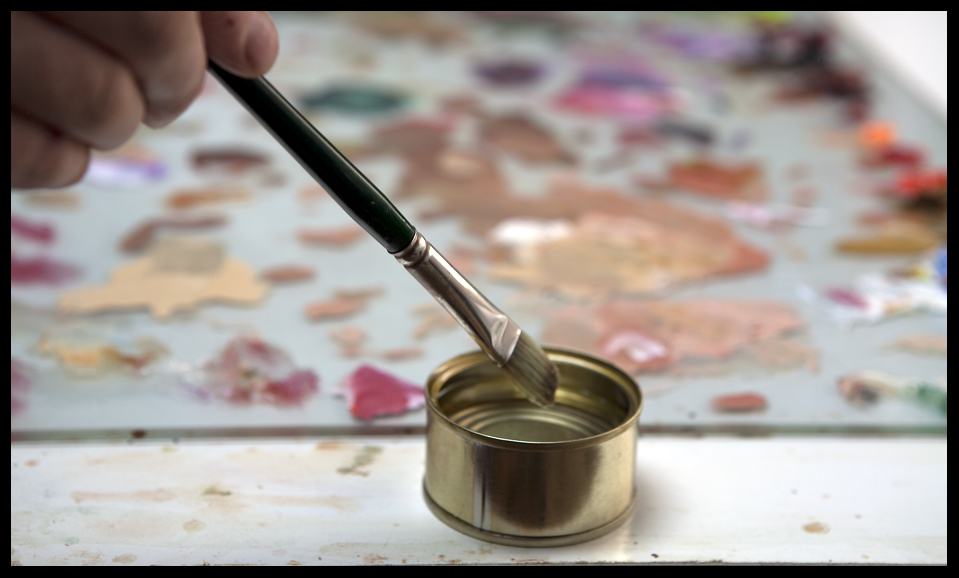About using painting medium.
One of the most asked questions in my portrait painting classes is about using painting medium. “When do I use painting medium?”
 Sometimes I might rub the whole canvas with a neutral drying medium just before starting to paint, I mean at the beginning of the day. I do so, because I want to make the canvas suitable for receiving my paint. Nothing is more annoying than paint not willing to come of your brush. Mixing the paint with medium on the palette also is a way to get the same result but there is a danger to use too much of the medium at once. I said “sometimes”. I depends on the canvas. If the canvas is really dry and sucking this approach is useful. If the prepared canvas is already oily then don´t do this. During the first stage, in the face, I hardly use any medium. In large background surfaces I might dilute paint with citrus turpentine; a thin wash as if it was watercolour. Later I come back with the right layer of paint. See also this page.
Sometimes I might rub the whole canvas with a neutral drying medium just before starting to paint, I mean at the beginning of the day. I do so, because I want to make the canvas suitable for receiving my paint. Nothing is more annoying than paint not willing to come of your brush. Mixing the paint with medium on the palette also is a way to get the same result but there is a danger to use too much of the medium at once. I said “sometimes”. I depends on the canvas. If the canvas is really dry and sucking this approach is useful. If the prepared canvas is already oily then don´t do this. During the first stage, in the face, I hardly use any medium. In large background surfaces I might dilute paint with citrus turpentine; a thin wash as if it was watercolour. Later I come back with the right layer of paint. See also this page.
Read what Talens says about using painting medium.
WHEN DO I USE PAINTING MEDIUM? Whether a medium is used depends on the chosen technique. With oil colours there are two possible techniques: ‘Allaprima’ and ‘layered painting’.
‘Allaprima’ means that the painting will be painted ‘wet-into-wet’. With this technique the colours are mixed not only on the palette but also on the painting itself, and the paint can be continued to be thinned with the same solvent or medium, or the paint can be used pure.
Layered painting means that the painting is made up of various layers. A subsequent layer can only be applied once the previous layer is dry enough for it to no longer dissolve. Meticulous use of the various solvents is advised in connection with the adherence of the individual layers. Through anchoring, oil colours adhere into a porous ground. If a thick layer of pure oil colour were to be allowed to dry, then this would not be porous enough for a good adherence of the next layer.
Layered painting uses a technique that is called ‘fat-over-lean’, which also can be described as flexible over less flexible. For the first layer the paint is thinned with white spirit or turpentine. Due to the thinning there is relatively little oil on the painted surface. The layer is ‘lean’.
Once the first layer is dry enough, the second layer is applied, thinned with Painting Medium. Talens Painting Medium consists of three components: oil, resin and white spirit. The extra added oil feeds the lean first paint layer by filling the pores that are formed by the evaporated solvent. At the same time this second layer can also adhere well to the underlying layer. The evaporation of the white spirit forms new pores which allow for the adherence of a subsequent layer. The third ingredient, resin, makes the paint layer stronger.
If we apply a third layer, we need to use a medium that is fatter still in order to feed and strengthen the underlying layers. If a painting is made of more layers, then the mentioned thinning agents can be mixed proportionately from lean to increasingly fatter.
The last layer to be applied is usually a glazing paint layer. Glazing is the application of a transparent layer of paint. No brush stroke may be seen in a glaze as the brush strokes of the underlying paint are visible. Various glazing mediums can be used, such as Talens Glazing Medium, Alkyd Medium, Venetian Turpentine and Stand Oil. These mediums are fatter than the painting medium and allow the paint to flow without showing any brush stroke.

I am a surgeon who lives in El Salvador, Central America. In my country I don’t have the oportunity to develope my hobby oil painting. I like your work and I bought your tutorial, the portrait of the boy. I would like that you perform many other tutorials to compensate the lack of opportunities to learn in my country.
Your work in really beautiful, congratulations.
Hola Fernando.
Gracias por tu mensaje.Estoy feliz sabiendo que te ha gustado mi tutorial. Estoy preparando más video y además subtitulado en Español. Antes de verano esta disponible el próximo.
Saludos desde España.
Hola Ben!!!!, ¿cómo puedo fijar pastel sobre lienzo??.
Muchas gracias por todos tus consejos!!!!!.
Un fuerte abrazo!!
Hola Cristina.
¿Que tal? Para fijar un pastel existe un fijador especial adrede para pastel que tienes que comprar. Pero un pregunta ¿Porque pastel sobre lienzo?
Un abrazo
Ben